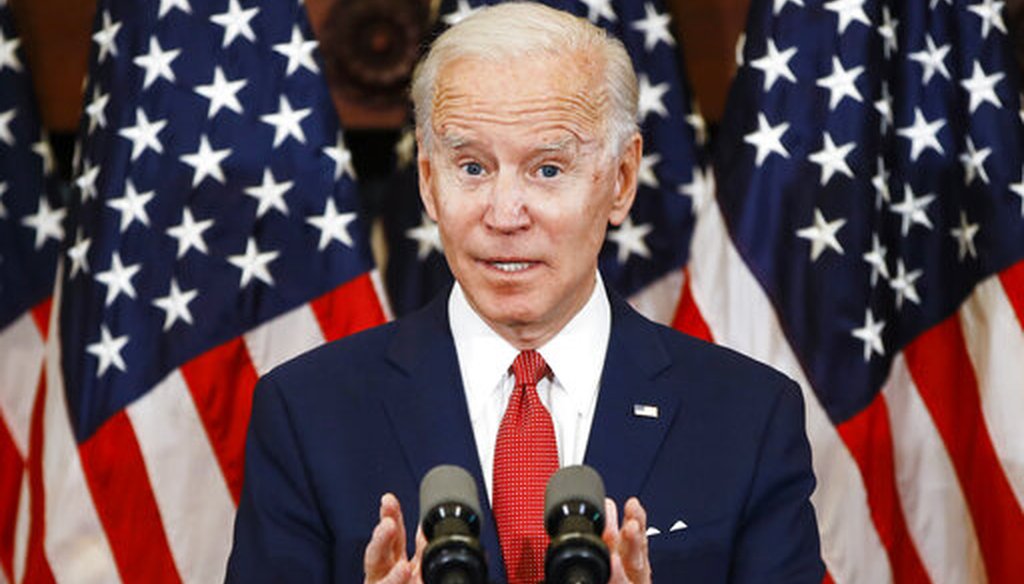

Our only agenda is to publish the truth so you can be an informed participant in democracy.
We need your help.


Democratic presidential candidate Joe Biden speaks in Philadelphia, June 2, 2020. (AP)
The gap in the homeownership rate between Blacks and whites is around 30 percentage points.
The Census Bureau does not have year-by-year homeownership data by race for the 1960s. However, the gaps in 1960 and 1970 were narrower than they are now.
Joe Biden does not support the call from racial-justice activists to "defund the police." In a USA Today op-ed, he proposed other policies for rooting out systemic racism in American laws and institutions, focusing on economic opportunities.
Homeownership is key to financial stability and building generational wealth, Biden wrote, yet the share of African Americans who own their homes is significantly lower than for whites.
"Today, the gap between African American and white homeownership is larger than it was in the late 1960s," Biden wrote in the June 10 op-ed. "We have to give local officials the tools to combat gentrification, end discriminatory lending practices, and eliminate exclusionary zoning laws designed to keep low-income people and people of color out of certain communities."
Is Biden right about the homeownership gap being larger now than in the late 1960s? His op-ed linked to an October 2019 report from the Urban Institute, a nonpartisan think tank. Researchers there told PolitiFact that Biden accurately referenced their findings, and their data aligned with the U.S. Census Bureau numbers, which also backed Biden’s claim.
The homeownership rate refers to the share of households living in owner-occupied homes, rather than renting.
The Urban Institute said that in 2017, the white homeownership rate was 71.9% compared with 41.8% for Blacks. (The gap was similar in 2019 and during the first quarter of 2020.) The Black homeownership rate in 2017 was at its lowest level in 50 years and also the lowest of all racial and ethnic groups, according to the Urban Institute.
"The racial homeownership gap between Black households and white households is more than 30 percentage points, which is greater than it was before the passage of the 1968 Fair Housing Act," the Urban Institute report said.
It’s difficult to say what the homeownership rate for Black and white Americans was in a given year in the 1960s, because the Census Bureau does not have yearly data on homeownership by race for that decade. (That detailed data is available for the 1970s and later.)
Still, the available data show the homeownership gap was lower in 1960 and 1970 than it is now.
Homeownership rate by race, according to a 1994 Census Bureau report:
1960: white 64.4%, Black 38.4% (26-point gap)
1970: white 65.2%, Black 41.6% (23.6-point gap)
The Urban Institute provided similar figures to PolitiFact for the 1960s and 1970s.
The homeownership rates for non-Hispanic Blacks and non-Hispanic whites generally decreased from 2007 through 2016. Since then, the rate for whites has been ticking back up, while Blacks have had a mix of up and down years.
RELATED: Fact-checking Mike Bloomberg’s response to redlining attack
Among the factors cited for the racial homeownership gap, according to the Urban Institute’s report:
Black Americans have lower median household income.
Black households are less likely to have a bachelor’s degree or higher education level, limiting income potential.
White households tend to have higher credit scores and longer credit histories.
Marital status has a "strong association" with homeownership rates, and residents of Black households are less likely to get married.
The racial gap in homeownership is also rooted in federal housing policies, created in the 20th century in response to the Great Depression, "that explicitly discriminated against African American, Latino, and other families of color by denying them access to federally insured mortgage programs because of their race," Nikitra Bailey, executive vice president of the Center for Responsible Lending, told a House committee in May 2019.
The recession of 2008-10 also "wiped out" 30 years of homeownership gains for African Americans, Bailey said. "Evidence shows that a large number of borrowers of color were targeted and steered into toxic mortgages, even when they qualified for safer and more responsible loans with cheaper costs."
Biden said, "Today, the gap between African American and white homeownership is larger than it was in the late 1960s."
This claim is supported by research from the Urban Institute and data from the Census Bureau.
We rate Biden’s statement True.
USA Today Joe Biden op-ed, Biden: We must urgently root out systemic racism, from policing to housing to opportunity, June 10, 2020
Urban Institute research report, Explaining the Black-White Homeownership Gap, October 2019, updated November 2019
Phone interview, Richard Rothstein, author of the book "The Color of Law," June 10, 2020
Email interview, Jung Choi, research associate with the Housing Finance Policy Center at the Urban Institute, June 10, 2020
Email interview, Nikitra Bailey, executive vice president at the Center for Responsible Lending, June 10, 2020
Email interview, Kristina Barrett, public affairs specialist at the U.S. Census Bureau, June 10, 2020
House Financial Services Committee, Testimony of Ms. Nikitra BaileyExecutive Vice President, Center for Responsible Lending, May 8, 2019
Tracking the American Dream, 50 years of housing history from the Census Bureau: 1940-1990, issued May 1994
PolitiFact, Donald Trump wrong that black homeownership rate is at a record high, Dec. 11, 2017
In a world of wild talk and fake news, help us stand up for the facts.
